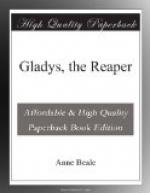This is what we see from the hawthorn lane below the house; but walking up into the highroad at the back, the scene changes, and just as our sympathies with beautiful nature were called forth below, so are they instantaneously assailed by our fellow-creatures above.
We come to the substantial gate that is the entrance to the pretty farm, and a curious and a motley group is there. We see such groups almost daily, here in Carmarthenshire; but as all the counties of England and Wales are not thoroughfares for the Irish from their country to England, we will describe these poor people as graphically as we can. There is evidently a consultation going on amongst them, and the general attention is directed to one individual of their party.
This is a young girl of some seventeen or eighteen years of age. She is seated on the ground, and leans her back against the stone wall that flanks the substantial gate afore mentioned. To judge from her general appearance she can scarcely belong to the ragged set that surround her, for there is an attempt at neatness and cleanliness in her attire, though it is poor enough, that the rest cannot boast of. She wears a cotton gown, shawl, straw bonnet, and shoes and stockings, which were once respectable and seem to have been originally intended for her. True, they are all worn and shabby-looking. The gown is faded, the bonnet very brown, and the shoes have holes in them; but they indicate a mind, or station, at least a degree above those of her companions. Her head is so inclined upon her breast, that it is difficult to see more than a pale face underneath the bonnet; but a pair of thin white hands that rest listlessly upon her lap, still tend to induce the notion that the girl cannot quite belong to the wild-looking company with which she is mixed up.
Right in front of her, and looking alternately from her to a man to whom she is talking, stands a middle-aged woman of good-natured but terrified aspect. A checked and ragged handkerchief confines her black, rough hair—a torn red cloak covers a portion of her body, and a curious collection of rags and tatters makes a vain effort to shelter the rest. In the large hood of the red cloak a hardy-looking infant is tied up, its little head and hand being alone visible, which are engaged in munching and holding a crust of bread. At the feet of the woman are sundry articles, amongst which a bundle of rags, an iron pot, and a tin saucepan, are the most conspicuous. The man to whom she is talking is a tall, gaunt specimen of Irish poverty and famine. He holds a rake and pitchfork in his hand, and leans upon them for support. Gazing into his face is a rough, surly-looking youth, who seems cordially to agree with all that he says.




